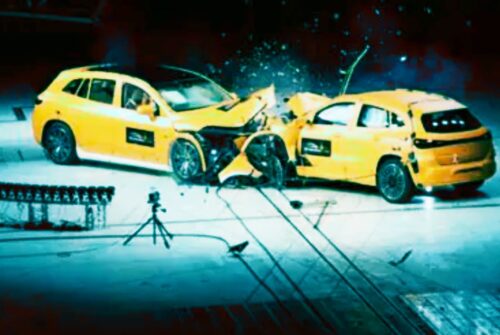
There’s a lot to unpack from what Mercedes is saying about its new crash test, because of what isn’t being said.
I’ll do my best to translate the important points found in The Driven.
Euro NCAP requires a frontal impact test that uses a 1,400kg trolley travelling at 50km/h with an aluminium honeycomb barrier that replicates the front of another vehicle.
Too light and too slow for EV conditions, especially given the massively heavy Tesla tend to crash head on into other cars going more like 100km/h.
Mercedes-Benz, however, recently decided to go one further – conducting a crash test between two of its own electric vehicles – the EQA and EQS SUV.
Like Volvo, Mercedes is aiming for real world data to improve chances of survival. It’s not just a checkmark game for them. They put two of their vehicles head-on at 56km/h.
“As a result, the passenger safety cell of both electric models remained intact, and the doors could still be opened. In an emergency, this would make it possible for occupants to exit the vehicle on their own or for first responders and rescue personnel to reach them.”
Tesla are well known to trap occupants after a crash, doors inoperable especially from the inside. First responders also often fail to get Tesla doors open. Multiple lawsuits and complaints from the grieving families of Tesla victims are related to obviously defective door safety.
The high-voltage system in both the EQA and the EQS SUV also switched off automatically during the collision, ensuring the safety of the battery and all components with a voltage above 60 volts.
Tesla is known to burst into electric fires, filling the car with toxic smoke and burning occupants alive as they struggle to open a door.
A total of four adult crash test dummies were involved – three females and one male. Analysis of the up to 150 measuring points per dummy showed a low risk of serious to fatal injury during the crash.
Women have different physical attributes but rarely if ever are represented in safety tests. This results in women being nearly 75 percent more likely to be injured in frontal road collisions.
…all safety equipment, including airbags and belt tensioners with belt force limiters, worked as intended.
Tesla deaths lately have had an uptick of people thrown from the car. Should we add belt failure to the list of things the low quality brand has engineered incorrectly?
All very important results that show a car company thinking hard about real engineering and real values. It’s clearly roasting meaningless high “safety” scores; overly contrived tests have been gamed by immoral Tesla engineers in order to defraud and even kill their customers. Mercedes can’t say that out loud, however.